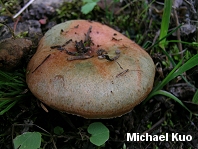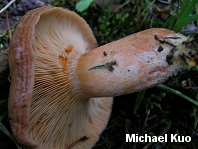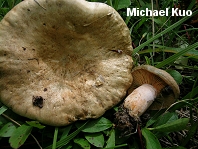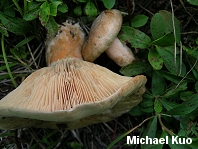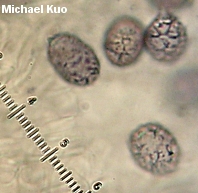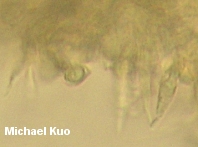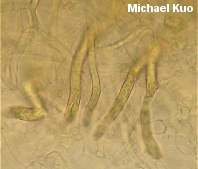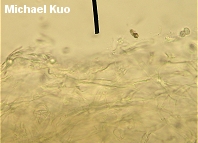| Major Groups > Gilled Mushrooms > Pale-Spored > Lactarius > Lactarius deliciosus var. areolatus |

|
Lactarius deliciosus var. areolatus [ Agaricomycetes > Russulales > Russulaceae > Lactarius . . . ] by Michael Kuo This is the common version of "Lactarius deliciosus" in the mountains of western North America, from Alaska to California and New Mexico. I find it at high elevations in southwest Colorado, where it associates with Engelmann spruce near treeline. When it grows in open, sunny areas at such high elevation, it often fades quickly and becomes dull and yellowish--but when growing in shaded areas it is typically orange and more reminiscent of other deliciosus-like mushrooms. Physical features separating Lactarius deliciosus var. areolatus from other varieties and species include its very scant milk, which stains the flesh deep red--and, under the microscope, its comparatively large spores, along with the absence of pleuromacrocystidia. DNA analysis (Nuytinck and collaborators, 2007b) has supported the idea that Lactarius deliciosus var. areolatus may be a distinct phylogenetic species, but a new name has not been proposed. DNA evidence is clear that it is not a variety of the European species Lactarius deliciosus--and its current varietal name, "areolatus," cannot be simply promoted to species rank because an entirely different species has already been named Lactarius areolatus. So we are left, for the time being, with an inadequate name--doubly so since the epithet areolatus, originally applied by Smith (1960) because the caps of the initially considered collections were cracked, was later revealed to be somewhat inappropriate: "we now regard the areolate condition of the cap in age as a nongenetically controlled one, and most likely resulting from drying in the conditions of low humidity prevailing so much of the time in central Idaho and Colorado" (Hesler & Smith 1979, p. 92). Description: Ecology: Mycorrhizal with conifers--primarily Engelmann spruce, lodgepole pine, and other high-elevation species; growing alone, scattered, or gregariously in subalpine ecosystems; summer and fall; western North America from Alaska to California and New Mexico. Cap: 3-15 cm across; at first convex, becoming broadly convex, flat, or shallowly vase-shaped; slightly sticky when very fresh, but soon dry; the margin sometimes inrolled when young; smooth or slightly roughened, becoming rugged and sub-scaly in age when exposed to sun and dry conditions; carrot orange or orange when fresh and when growing in shade, but soon dull brownish yellow or dirty buff when exposed; with or without concentric zones of color; becoming stained and discolored greenish by maturity. Gills: Attached to the stem or beginning to run down it; close; orange; bruising very slowly red, then green; frequently entirely greenish at maturity. Stem: 2-6 cm long; 1-3 cm thick; orange; more or less equal; smooth; without potholes; often becoming hollow; bruising and staining like the cap. Flesh: Whitish to pale orangish; staining slowly deep purplish red when sliced, especially in the stem base and over the gills. Milk: Very scanty (according to Hesler & Smith "the field character most frequently mentioned by collectors is the difficulty of demonstrating any latex at all"); orange; staining tissues slowly deep red, then green. Odor and Taste: Odor not distinctive; taste mild to slowly slightly acrid. Chemical Reactions: KOH negative on cap surface. Spore Print: Pale yellowish. Microscopic Features: Spores 8.5-11 X 6-8.5 µ; ellipsoid; ornamentation up to 0.5 µ high, as amyloid warts and ridges forming partial reticula. Pleuromacrocystidia absent. Cheilomacrocystidia inconspicuous; fusiform; to about 50 µ long. Lactiferous hyphae conspicuous; ochraceous in KOH. Pileipellis an ixocutis. REFERENCES: A. H. Smith, 1960. (Hesler & Smith, 1979; States, 1990; Evenson, 1997; Methven, 1997; Nuytinck et al., 2006; Nuytinck et al., 2007b.) Herb. Kuo 08080503, 08170803. DBG: RMNP 2008-020, 2008-068, 2008-111. This site contains no information about the edibility or toxicity of mushrooms. |
© MushroomExpert.Com |
|
Cite this page as: Kuo, M. (2011, March). Lactarius deliciosus var. areolatus. Retrieved from the MushroomExpert.Com Web site: http://www.mushroomexpert.com/lactarius_deliciosus_areolatus.html |
